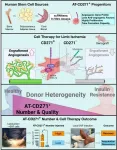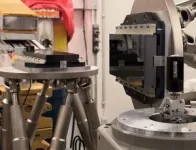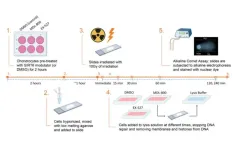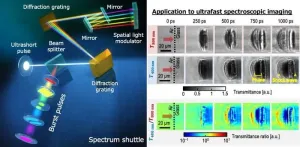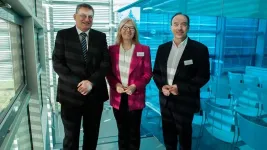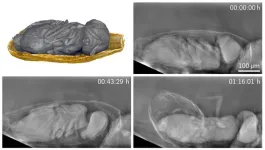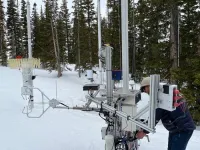(Press-News.org) Across the United States, about 2 million people are living with an amputation and another 185,000 amputations occur every year, according to the Amputee Coalition, a Washington DC-based support group. About 54% of these lost limbs were caused by vascular disease, including diabetes and peripheral arterial disease (PAD).
And as more people are diagnosed with diabetes, in the US and worldwide, the number of amputations keeps rising.
Now, experts at Cincinnati Children’s in collaboration with colleagues from Kanazawa University in Japan, have uncovered a new way to prompt blood vessel growth that shows promise as a treatment for preventing ischemia-induced amputations. Their discoveries were based on achieving a deeper understanding about why two patients in a clinical trial in Japan walked away with fully recovered limbs that appeared destined for amputation.
The study, published Dec. 19, 2023, in the journal Cell Reports Medicine, was led by first author Oto Inoue, MD, PhD, a cardiologist from Japan and a research fellow with Cincinnati Children’s, and Juan Sanchez-Gurmaches, PhD, Division of Endocrinology.
Their team reports that a specific subset of stem cells isolated from adipose tissue (fat) that also carry the cell surface marker CD271 outperformed all other similar cell types at inducing blood vessel formation. The study also details key molecular mechanisms involved the process.
The scientists confirmed these findings by transplanting this population of human stem cells into in mice with limb ischemia. In every case, the treatment rescued limbs that otherwise would have required amputation.
Then the team analyzed data from a clinical trial to provide initial evidence that such a cell transplant may have already worked in humans. In this case, people with foot ulcers were treated with a generalized mix of stem cells collected from the patients’ own tissues. Of the small number of patients analyzed, the two patients with fully recovered limbs received high numbers of CD271-positive stem cells. Those results in combination with the highly consistent benefits found in the mouse testing, appear to justify further work to launch a formal clinical trial, the co-authors say.
“Critical limb ischemia is one of the most severe outcomes for PAD and undertreated diabetes. This research shows hopeful results that this new subset of progenitors may have positive therapeutic value,” Inoue says. “It was quite inspiring to see that one of the patients has recovered enough to return to work.”
A race to address a widespread health problem
With rising rates of obesity plaguing the United States, diabetes incidence has been rising for years, and leading to a host of cardiovascular complications, including PAD leading to critical limb ischemia.
Doctors treat PAD by using medications to slow the disease while performing bypass surgeries or catheter-based procedures to open clogged arteries in the limbs. However, many of the arteries that need treatment in the limbs are too small and difficult to access with surgery. As a result, at least a third of the people who need revascularization therapy are not eligible for surgical interventions. Those who lose their limbs go on to experience significant pain and disability while their underlying cardiovascular disease makes them increasingly likely to experience potentially fatal heart attacks, strokes, and other problems.
Once seen as a purely adult health problem, researchers at Cincinnati Children’s and other centers have been finding early signs of vascular disease in teens and even younger children who struggle with severe obesity and diabetes.
Emerging alternatives from international collaboration
Inoue, 40, has been studying PAD in Japan for more than a decade. He came to Cincinnati in 2021 to further study the emerging area of induced angiogenesis through cellular transplantation as a member of the Sanchez-Gurmaches lab.
Many researchers have explored the idea of transplanting progenitor cells to jump-start the body’s own tissue-repair capabilities. However, the major limitation has been finding the right cells to use.
To solve this, the team used single-cell transcriptomics to hunt through a haystacky of different types of progenitor cells to find the right population of cells. While many stem cells reside naturally in the bone marrow, this study found the strongest trigger of blood vessel formation lurking within fat tissue. These cells carry the marker CD271, which has been shown in other studies to play important roles in tissue growth.
The team transplanted these human CD271-positive cells into mice to confirm their abilities. The human CD271 cells were 100% effective at prompting enough blood vessel growth in the mice to restore normal blood flow to the diseased limbs.
Evidence that this new cell population may work in human disease also was provided. The authors found that among people who received progenitor cells self-transplanted from fat, those who recovered better and saved their limbs had higher numbers of CD271 progenitor cells present.
“The positive correlation between recovery and the number of CD271+ progenitors injected in the affected area of these patients was striking,” Sanchez-Gurmaches says.
Challenges ahead
The co-authors emphasize that the findings so far are preliminary. The therapeutic value of adipose tissue CD271-positive cells should be evaluated in larger numbers of patients through a formal clinical trial.
One significant issue to resolve is how to obtain enough CD271 progenitor cells to use as treatment. The new paper reports that the number of CD271 progenitors found in the fat of people with insulin resistance can be as much as 75% lower than people without insuline resistance. Also, the cells that are found tend to be less active in generating new vessels.
“Unfortunately, the people living with insulin resistance who face elevated risk of limb ischemia are the same people with low numbers of CD271-postive progenitor cells, which could make self-transplantation more difficult,” Inoue says.
More research is needed to determine if these cells can be multiplied in the lab before transplantation.
About the study
In addition to Inoue and Sanchez-Gurmaches, Cincinnati Children’s co-authors included PhD student Manasi Halurkar, Hee-Woong Lim, PhD, and Vivian Hwa, PhD.
Funding sources for this study include the National Institutes of Health (R21OD031907); the Japan Society for the Promotion of Science (JP16H06828); the Japanese Heart Foundation; the American Heart Association (18CDA34080527), and three grants from Cincinnati Children’s (a Trustee Award, a Center for Pediatric Genomics Award and a Center for Mendelian Genomics & Therapeutics Award.
END
Novel approach emerging for rescuing limbs at risk
Scientists in Cincinnati and Japan identify a population of progenitor cells that strongly promote new blood vessel growth in ischemic limbs at risk of amputation from diabetes and other conditions
2023-12-19
ELSE PRESS RELEASES FROM THIS DATE:
Socialization for success: Two recent studies expand our understanding of how early social housing helps dairy calves thrive
2023-12-19
Philadelphia, December 19, 2023 – Dairy industry professionals continuously work to ensure the highest possible welfare for dairy calves, including fine-tuning their housing to improve overall health, well-being, and performance. Two new studies in JDS Communications are illuminating our understanding of paired housing in the critical newborn and pre-weaned stages of dairy lives by showing that housing designed to facilitate early socialization can build behavior skills, shape calf personalities, and ultimately, set up animals ...
Sirtuin 6 activation rescues the age-related decline in DNA damage repair in chondrocytes
2023-12-19
“[...] the biological mechanisms linking aging and osteoarthritis prevalence remain largely unknown.”
BUFFALO, NY- December 19, 2023 – A new research paper was published in Aging (listed by MEDLINE/PubMed as "Aging (Albany NY)" and "Aging-US" by Web of Science) Volume 15, Issue 23, entitled, “Sirtuin 6 activation rescues the age-related decline in DNA damage repair in primary human chondrocytes.”
While advanced age is widely recognized as the greatest risk factor for osteoarthritis (OA), the biological mechanisms behind this connection remain unclear. Previous work has ...
Innovative optical technique for simultaneously producing and shaping gigahertz burst pulses
2023-12-19
The generation and manipulation of high-repetition pulses hold great promise across various applications, including high-speed photography, laser processing, and acoustic wave generation. Gigahertz (GHz) burst pulses, with intervals ranging from ~0.01 to ~10 nanoseconds, are particularly valued for visualizing ultrafast phenomena and improving laser processing efficiency.
While methods for producing GHz burst pulses exist, challenges persist, such as low throughput of pulse energy, poor tunability of pulse intervals, and the complexity ...
3D material found to break down antidepressant that contaminates water bodies worldwide
2023-12-19
An article published in the Chemical Engineering Journal describes a strategy to produce a material based on zinc oxide (ZnO) capable of degrading sertraline, an antidepressant that has been detected, like other drugs, in groundwater worldwide and is considered an emerging pollutant. This kind of substance has certain physicochemical properties that hinder removal by conventional wastewater treatment methods.
The research was supported by FAPESP and conducted in Brazil by scientists at the Center for Development of Functional Materials (CDMF), the Brazilian ...
High Performance Computing Center of the University of Stuttgart and Hewlett Packard Enterprise to build exascale supercomputer
2023-12-19
The University of Stuttgart and Hewlett Packard Enterprise (HPE) have announced an agreement to build two new supercomputers at the High-Performance Computing Center of the University of Stuttgart (HLRS).
In the first stage, a transitional supercomputer, called Hunter, will begin operation in 2025. This will be followed in 2027 with the installation of Herder, an exascale system that will provide a significant expansion of Germany’s high-performance computing (HPC) capabilities. Hunter and Herder will offer researchers ...
Gentle x-ray imaging of small living specimens
2023-12-19
X-ray imaging visualizes hidden structures and processes in living cells and organisms. The radiation that consists of highly energy-rich electromagnetic waves, however, has an ionizing effect and may damage the genetic material. This limits the possible observation period. While conventional X-ray images of soft tissue are of low contrast, phase contrast methods produce far better image contrasts at a reduced radiation dose. With higher resolution, however, gentle imaging becomes increasingly difficult, as a higher dose is required. Moreover, ...
Pushing compressed sensing to real-time edge applications
2023-12-19
Recently, a research team led by Prof. Sun Zhong at Peking University reported an analog hardware solution for real-time compressed sensing recovery, which has been published as an article titled "In-memory analog solution of compressed sensing recovery in one step" in Science Advances. In this work, a design based on a resistive memory (also known as memristor) array for performing instantaneous matrix-matrix-vector multiplication (MMVM) is first introduced. Based on this module, then an analog matrix computing circuit that solves compressed sensing (CS) recovery in one step (within few microseconds) is disclosed.
CS ...
The science behind snowflakes
2023-12-19
Tim Garrett has devoted his scientific career to characterizing snowflakes, the protean particles of ice that form in clouds and dramatically change as they fall to Earth.
Now the University of Utah atmospheric scientist is unlocking the mystery of how snowflakes move in response to air turbulence that accompanies snowfall using novel instrumentation developed on campus. And after analyzing more than half a million snowflakes, what his team has discovered has left him astonished.
Rather than something incomprehensibly complicated, predicting how snowflakes move proved to be surprisingly ...
COVID-19 infection causes teen’s vocal cord paralysis in first-of-its-kind case
2023-12-19
Physician-researchers from Mass Eye and Ear, a member of Mass General Brigham, report the first pediatric case of bilateral vocal cord paralysis after COVID-19 (SARS-CoV-2) infection. The patient, an otherwise healthy 15-year-old female, came to the emergency department at Massachusetts General Hospital with symptoms of respiratory distress nine days after diagnosis with SARS-CoV-2 infection. Examination with an endoscope revealed bilateral vocal cord paralysis, which is an immobility of both vocal cords found in the larynx or voice box. The researchers concluded that this paralysis was likely a downstream ...
Vervet monkeys follow different social “norms” and respond to “peer pressure,” new long-term study shows
2023-12-19
People living in different communities follow different social customs or norms. In some places, for instance, it might be standard practice to greet each person you see on the street, while in others that simply isn’t done. In some cases, such differences may even vary from one neighborhood to the next. Now researchers reporting in the journal iScience on December 19 have found similarly varied social traditions and styles among neighboring groups of vervet monkeys.
“We report the existence of behavioral traditions of social customs in vervet ...
LAST 30 PRESS RELEASES:
Cannabis derivatives could provide new ovarian cancer treatments
Raising strong yeast as a petroleum substitute
Clues to the origin of hot Jupiters hidden in their orbits
Canada’s reduced pledge to Global Fund will impact domestic health
1 in 4 children with major traumatic injuries not cared for in pediatric trauma centres
Duke and Duke-NUS’ joint cross-population research to uncover "East-West" differences in disease and care
Scientists to ‘spy’ on cancer- immune cell interactions using quantum technology breakthrough
Tech savvy users have most digital concerns
Making lighter work of calculating fluid and heat flow
Normalizing blood sugar can halve heart attack risk
Lowering blood sugar cuts heart attack risk in people with prediabetes
Study links genetic variants to risk of blinding eye disease in premature infants
Non-opioid ‘pain sponge’ therapy halts cartilage degeneration and relieves chronic pain
AI can pick up cultural values by mimicking how kids learn
China’s ecological redlines offer fast track to 30 x 30 global conservation goal
Invisible indoor threats: emerging household contaminants and their growing risks to human health
Adding antibody treatment to chemo boosts outcomes for children with rare cancer
Germline pathogenic variants among women without a history of breast cancer
Tanning beds triple melanoma risk, potentially causing broad DNA damage
Unique bond identified as key to viral infection speed
Indoor tanning makes youthful skin much older on a genetic level
Mouse model sheds new light on the causes and potential solutions to human GI problems linked to muscular dystrophy
The Journal of Nuclear Medicine ahead-of-print tip sheet: December 12, 2025
Smarter tools for peering into the microscopic world
Applications open for funding to conduct research in the Kinsey Institute archives
Global measure underestimates the severity of food insecurity
Child survivors of critical illness are missing out on timely follow up care
Risk-based vs annual breast cancer screening / the WISDOM randomized clinical trial
University of Toronto launches Electric Vehicle Innovation Ontario to accelerate advanced EV technologies and build Canada’s innovation advantage
Early relapse predicts poor outcomes in aggressive blood cancer
[Press-News.org] Novel approach emerging for rescuing limbs at riskScientists in Cincinnati and Japan identify a population of progenitor cells that strongly promote new blood vessel growth in ischemic limbs at risk of amputation from diabetes and other conditions
